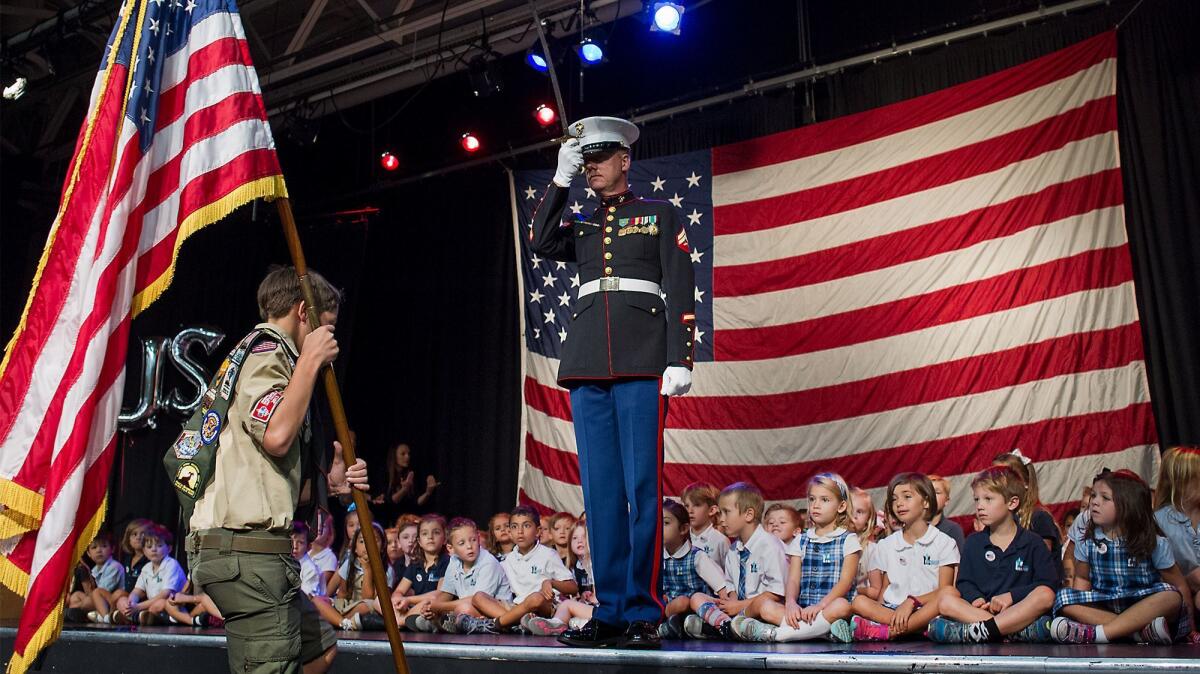Commentary: Veterans Day should serve as a reminder that the military is more diverse than perceived

- Share via
On this Veterans Day, let’s take an opportunity to dispel a few misconceptions about veterans.
First off, veterans tend to look different than the “all-American hero” stereotype some people might imagine. Indeed, the military is in many ways as diverse as the rest of the nation. A full 30% of the active military and selected reserve force identifies as black or Latino, which is about the same as the percentage nationwide.
And while women remain underrepresented in the armed services, the 2015 decision by the Chairman of the Joint Chiefs to open all military jobs (including combat roles) to women who can meet the established standards has been quietly shifting the landscape. As of August there were 278 female Marines filling jobs that were previously unavailable to them.
Consider this: I graduated from the Naval Academy with a degree in Aerospace Engineering and spent my first tour as the gunnery and ordnance officer on a guided missile cruiser at sea. I bet the image that just popped into your head wasn’t of a 5-foot-4 Latina.
Another underreported story is the rate of veteran unemployment, down to 5.1% in 2016 compared to 12% in 2011. It’s important to recognize that the national attention that was paid to veterans’ unemployment yielded positive results, however that attention had the unfortunate byproduct of contributing to the culture of pitying rather than respecting veterans.
I was recently talking about how I started working in energy efficiency after I left the Navy, but was interrupted by someone commenting almost reflexively, “That must have been hard for you.” It took me a moment to recognize that this person was assuming that I’d had a hard time finding a job simply because I was a veteran.
A similar strain in the civil-military divide is even more obvious, however, when discussing mental health. In the first episode of Season 9 of “Curb Your Enthusiasm,” at the first mention of a veteran, Larry David warns of PTSD nightmares and violence. While cringeworthy, this is a shockingly common portrayal of veterans in the media, a phenomenon that has been well documented and sometimes referred to as the “ticking time bomb” myth.
We are considered heroes and simultaneously damaged goods in need of help. Veterans seeking mental care, like all patients of any group, have specific individual needs and while there is absolutely a need to continue to invest in veteran mental health for those that need it, it cannot be the only perspective from which we are viewed.
All of this gets at the idea that veterans, despite how we’re depicted in the media or popular entertainment, don’t all look the same or have the same experiences. We don’t vote the same or feel the same way about issues of the day, either.
Most recently, veterans were used as the moral authorities in the debate over standing for the national anthem during football games. Arguing that all veterans feel one way or another about an issue is simplistic at best and insulting at worst.
An Iraq and Afghanistan Veterans of America poll showed that 62% of their membership felt that NFL players had the right to peacefully protest while the VFW and American Legion both strongly condemned the players for “disrespecting service members.”
The strong difference in opinion between the two camps may be attributable to the average age of membership with Iraq and Afghanistan veterans consisting mostly of young, post-9/11 veterans.
The generational divide within the population of veterans also partly explains partisan expectations. Veterans have traditionally been labeled as Republican and while that holds true in a recent Pew poll, a full 50% of the veteran population in that poll was over the age of 65. In the absence of good polling data, my anecdotal belief is that younger, more diverse veterans are more evenly split between the two parties.
The organization Got Your 6 works on perceptions of veterans in the media. Their research suggests that when the “damaged all-American male hero” stereotype is pointed out and discussed, Americans are able to dismiss it and see past the myth.
On this Veterans Day, I ask that you don’t just thank a veteran for their service but that you take a moment to consider your own stereotypes. Got Your 6 has a suggestion for you as well: They suggest that we look to veterans as “civic assets who have unique and valuable skills that can help strengthen our communities.”
I couldn’t agree more.
ANDREA MARR is a U.S. Navy veteran and Costa Mesa City Council candidate.
All the latest on Orange County from Orange County.
Get our free TimesOC newsletter.
You may occasionally receive promotional content from the Daily Pilot.



